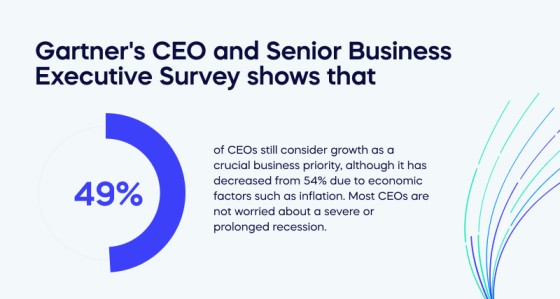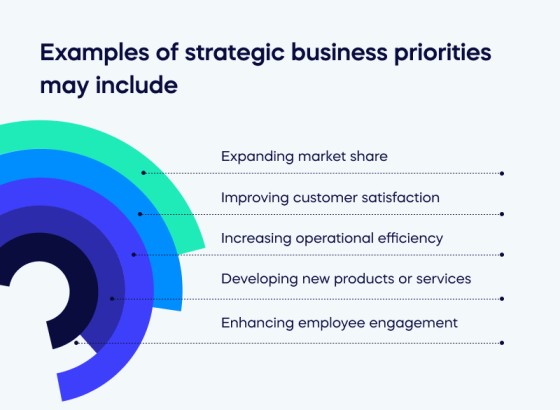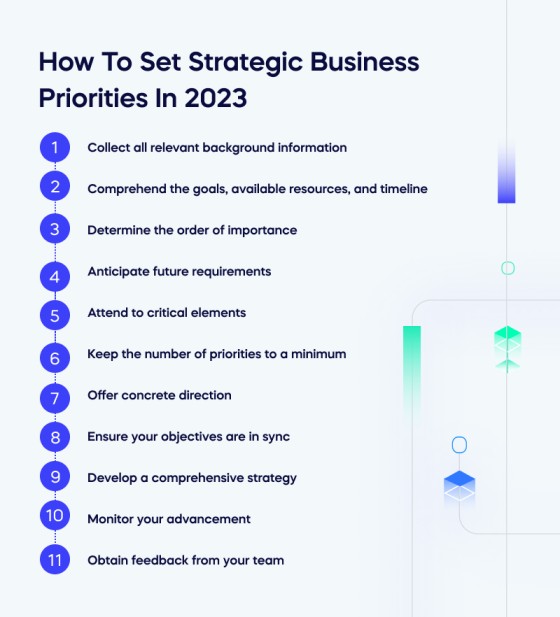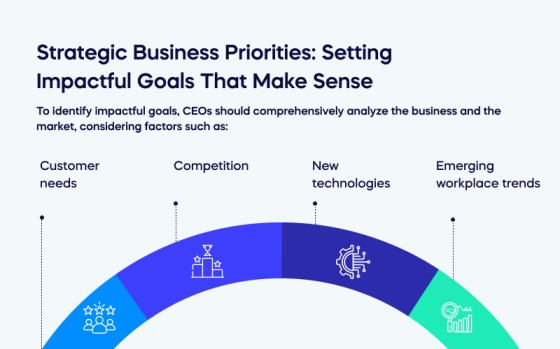Leadership is a complex and multifaceted role that requires identifying trade-offs and deciding what is important to prioritize.
A smart leader understands that their job involves deciding what to do and what not to do. In an environment with finite resources, determining the importance of various initiatives becomes a crucial test of transformational leadership.
As leaders, it is easy to become overwhelmed by multiple competing demands. They must weigh the costs and benefits of each initiative and determine which ones align most closely with their goals and objectives. This requires a deep understanding of the organization’s culture.
Gartner’s CEO and Senior Business Executive Survey shows that 49% of CEOs still consider growth as a crucial business priority, although it has decreased from 54% due to economic factors such as inflation. Most CEOs are not worried about a severe or prolonged recession. Hence, the current objective should be developing a growth plan for three to seven years.

Therefore, effective leadership requires a combination of strategic thinking, critical analysis, and decision-making skills. Leaders must be able to evaluate different options, determine their impact on the organization, and make tough choices based on the available resources.
Leaders who can identify trade-offs and make sound decisions are better equipped to navigate the complexities of today’s business environment.
This article will provide strategies for setting and prioritizing strategic business priorities in 2023. It will help leaders better understand their organizations, assess trade-offs, and determine what initiatives should be prioritized.
What Are Strategic Business Priorities?
Strategic business priorities are the most important goals, initiatives, and focus areas an organization must pursue to achieve its long-term vision and mission. These priorities are identified through a strategic planning process considering various internal and external factors such as market trends, customer needs, competitive pressures, and resource availability.
Once established, strategic business priorities guide decision-making and resource allocation across the organization. They provide a framework for aligning business functions, processes, and activities to achieve common objectives and outcomes.

Examples of strategic business priorities may include expanding market share, improving customer satisfaction, increasing operational efficiency, developing new products or services, or enhancing employee engagement. Effective management of strategic business priorities is critical for achieving sustainable growth, maintaining competitiveness, and creating long-term value for stakeholders.
Why Are Strategic Business Priorities Important?
Identifying and setting strategic business priorities has become increasingly crucial for the organization’s long-term success. For businesses to achieve their goals in 2023 and beyond, it is important to establish strategic priorities to help them focus their efforts and allocate their resources effectively.
Adopting a strategic approach to enterprise planning allows organizations to identify key initiatives to drive growth and profitability, streamline operations, and align internal teams and external partners around a common objective. A well-defined set of strategic priorities can help companies to stay ahead of emerging trends, respond quickly to market changes, and capitalize on new opportunities.
By aligning their business objectives with strategic priorities, businesses can use their resources more efficiently and become more flexible and robust. This also allows them to become more competitive compared to other players in the market.
How To Set Strategic Business Priorities In 2023

A well-defined strategic plan is the foundation of any successful business.
It requires a deep understanding of the market, customers, and competition and making informed decisions based on available resources. To achieve long-term success, businesses must prioritize efficiently, anticipate future requirements, and monitor progress.
We’ve outlined the following steps to ensure that you set the right strategic business priorities in 2023:
Collect all relevant background information
Collecting all relevant background information is essential in developing a strategic business plan, as it allows you to gain insight into the market, industry, and competitive landscape. Understanding market trends, customer needs, and competition can help you make informed decisions about your business strategy.
By gathering data on your target audience, you can pinpoint their preferences, behavior patterns, and pain points, allowing you to tailor your marketing efforts to reach them more effectively. Conducting a thorough analysis of your industry, competitors, and potential market disruptions enables you to identify opportunities and potential challenges.
This information can be used to develop a sound business model that aligns with your goals and creates a solid foundation for growth.
Comprehend the goals, available resources, and timeline
When creating a strategic business plan, it’s important to comprehend the goals, available resources, and timeline. Clear objectives will help you stay focused on your goals and ensure that every decision you make supports those objectives.
Available resources are also crucial as they determine your ability to execute your plan. Identifying your resource constraints can help you plan for contingencies and allocate your resources most efficiently. A realistic timeline will help you allocate your resources optimally and keep everyone on track.
You should also consider external factors such as regulatory requirements, market trends, and technological advancements that may affect your timeline.
Determine the order of importance
Prioritization is critical in business strategy development. Identifying the most important priorities and ranking them in order of significance will help you focus on the most crucial areas of your business first.
Prioritization allows you to allocate resources and capital more efficiently, ensuring that you invest in areas with the greatest potential for growth and success. It also helps you avoid spreading yourself too thin and becoming ineffective.
Anticipate future requirements
Anticipating future requirements is essential in strategic business planning. By looking forward and anticipating the needs of your customers, industry, and competitors, you can stay ahead of trends and create a sustainable competitive advantage.
This involves analyzing market trends, emerging technologies, and customer behavior patterns.
By staying abreast of these factors, you can make informed decisions about where to invest resources and develop solutions that meet future needs.
Attend to critical elements
Critical elements are the most important aspects of your business that require immediate attention. These may include customer service, quality control, product innovation, or cost management.
Attending to these critical elements first will ensure that your business operates efficiently and effectively, enabling you to maintain your competitive advantage and achieve your objectives.
Keep the number of priorities to a minimum
Attempting to achieve too many priorities simultaneously can result in inefficient resource allocation, lack of focus, and poor execution. It’s important to keep the number of priorities to a minimum to avoid overwhelming the team and diluting the impact of your efforts.
A smaller set of priorities allows for greater focus, more efficient resource allocation, and improved execution.
Offer concrete direction
Offering concrete direction is an essential component of strategic business planning. Clear direction provides guidance and clarity to your team on where you’re going and how you will get there.
It also helps align everyone towards a common goal and ensures everyone is working towards the same objectives.
Ensure your objectives are in sync
Ensuring that your objectives are in sync is critical to the success of your strategic business plan. All strategic objectives should be aligned with your overall business goals. This means that each objective should be complementary to one another, and they should work together to support your overarching strategy.
When objectives are in sync, it reduces the risk of conflicts arising, improves resource allocation, and increases the chances of achieving your business goals.
Develop a comprehensive strategy
Developing a comprehensive strategy is the backbone of successful strategic business planning. A comprehensive strategy involves analyzing the strengths and weaknesses of your business, identifying opportunities and threats, assessing the competitive landscape, and developing a roadmap for achieving your goals.
Developing a comprehensive strategy requires a deep understanding of your business and industry and the ability to take a holistic approach to problem-solving.
Monitor your advancement
Monitoring your advancement is essential to ensure you’re on track to achieving your objectives. By tracking your progress, you can identify areas for improvement, adjust your strategy if necessary, and make informed decisions about resource allocation.
Monitoring also helps to identify potential problems early, allowing you to take corrective action before they become major issues.
Obtain feedback from your team
Obtaining feedback from your team is an important part of strategic business planning. Your team can provide valuable insights into areas that require improvement and offer suggestions for overcoming challenges.
By involving your team in the process, they are more likely to be invested in the plan’s success and feel motivated to contribute to its execution. Feedback can also help you identify any gaps in your plan and make necessary adjustments
Strategic Business Priorities: Setting Impactful Goals That Make Sense

As the highest-ranking executive, the CEO sets the strategic business priorities that define the organization’s direction.
Effective goal-setting plays a crucial role in achieving these objectives, and it is the CEO’s responsibility to ensure that goals are SMART. They should be aligned with the company’s mission and values, focused on critical areas of the business, and communicated effectively throughout the organization.
To identify impactful goals, CEOs should comprehensively analyze the business and the market, considering factors such as customer needs, competition, new technologies, and emerging workplace trends. Based on this analysis, the CEO can prioritize goals based on their potential impact on the organization’s bottom line, customer satisfaction, and employee engagement.
CEOs should also monitor progress toward achieving the goals and adjust as needed. This requires a data-driven approach, regularly tracking and analyzing key performance indicators (KPIs) to ensure the organization progresses.
The CEO can more effectively set and achieve strategic business priorities by following these steps. This approach ensures that goals are aligned with the organization’s mission and values, focused on critical areas of the business, and communicated effectively throughout the organization, leading to greater overall success in 2023 and beyond.


